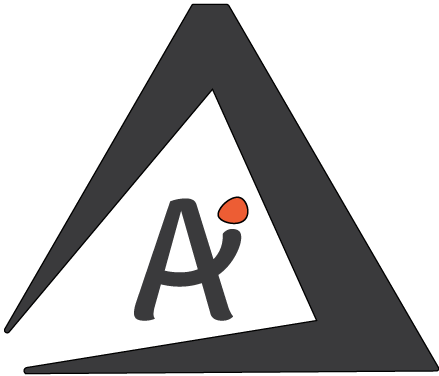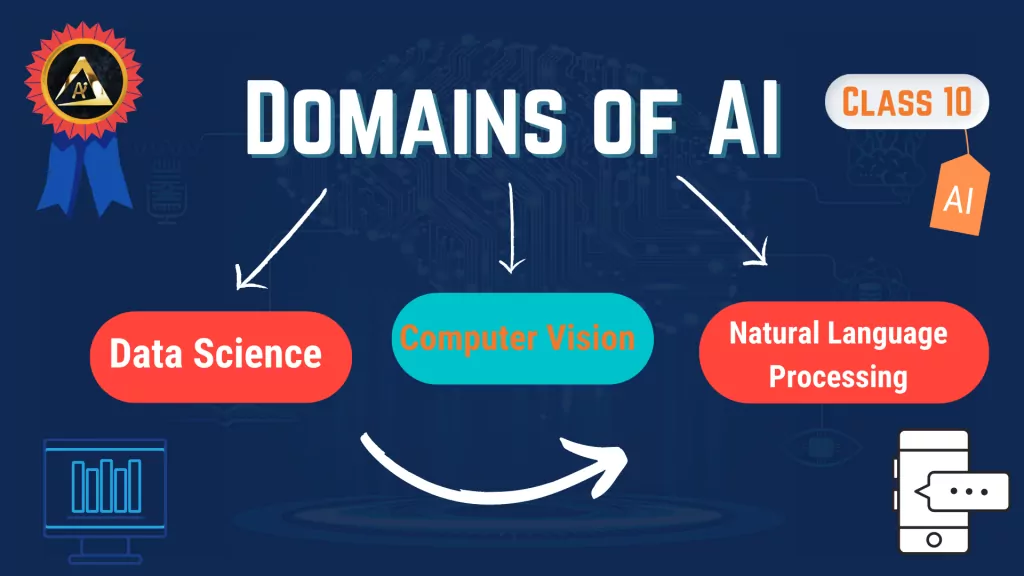Domains of AI Glossary Class 10
Domains of AI | Data Science | Data |
Data Sources | DataSets | What is Information |
Data vs Information | Types of Data | Big Data |
Computer Vision | Image Recognition | CBIR |
NLP | NLU | NLG |
Domains of AI Overview
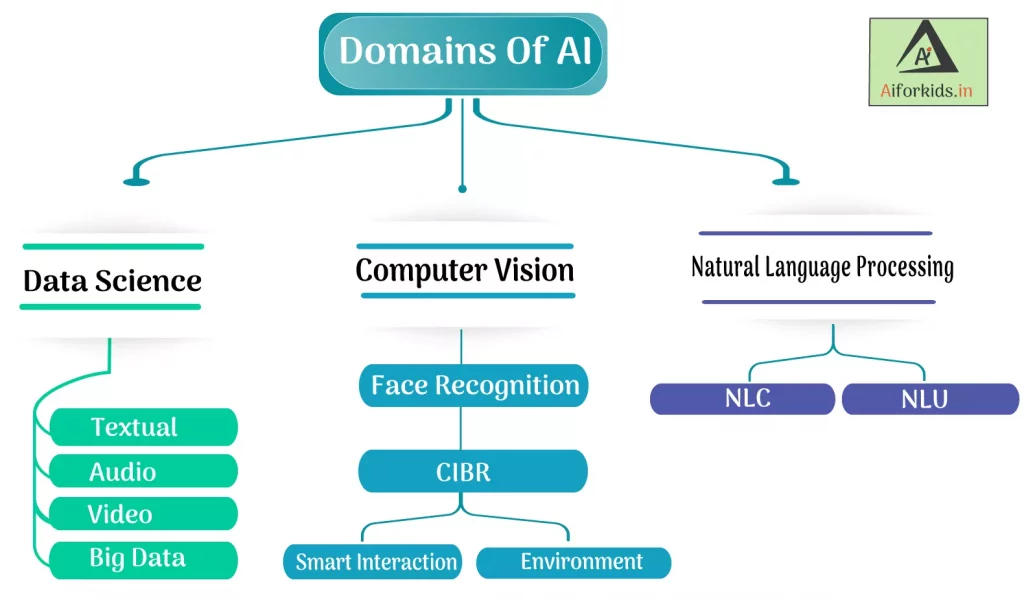
What are Domains of AI ?
Domains of AI refer to the main Branches of Artificial Intelligence for ex: Data, Computer Vision and Natural Language Processing
The Flowchart below is representing the 3 domains of Artificial Intelligence
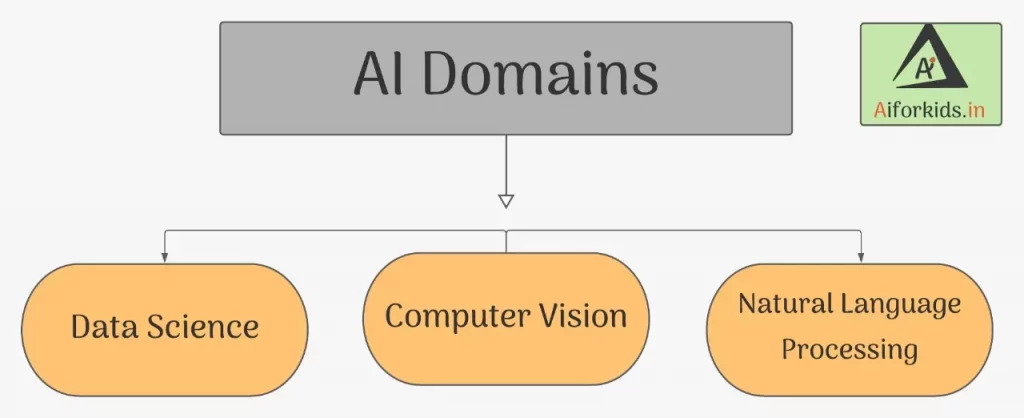
Data Sciences ( Data )
“Data Scientist is an artist who joins all the loose ends of data together to find the optimum solution for a problem and making it into Artful Intelligence.”
S. Rajeswara Sastry
(Independent Researcher & Certified Data Scientist)
Data Science is all about applying mathematical and statistical principles to data or In simple words, Data Science is the study of Data, This data can be of 3 types – Audio, Visual and Textual.
What is Data?
How do we spend most of our time in this tech era, On Internet? The whole Internet is based on data, you search for one result on Amazon and you get so many recommendations, How?
The principle of recommendation Engine is implemented here, just for understanding, we can think it like, a lot of data is given to these recommendation engines and they analyze the patterns like in which category you were searching from last week, etc, and hence this will recommend you the desired products.
Data is a collection of raw facts which can be processed to make Information out of it. The data can be in the form of numbers, words, symbols, or even pictures for example:
Data in different forms :
| Numbers | 10, 20, 2006, 29, 06 etc |
| Words | Something, Learning, Thankyou, etc |
| Symbols | ≈ ♛♚ ☁ Σ |
Data Sources
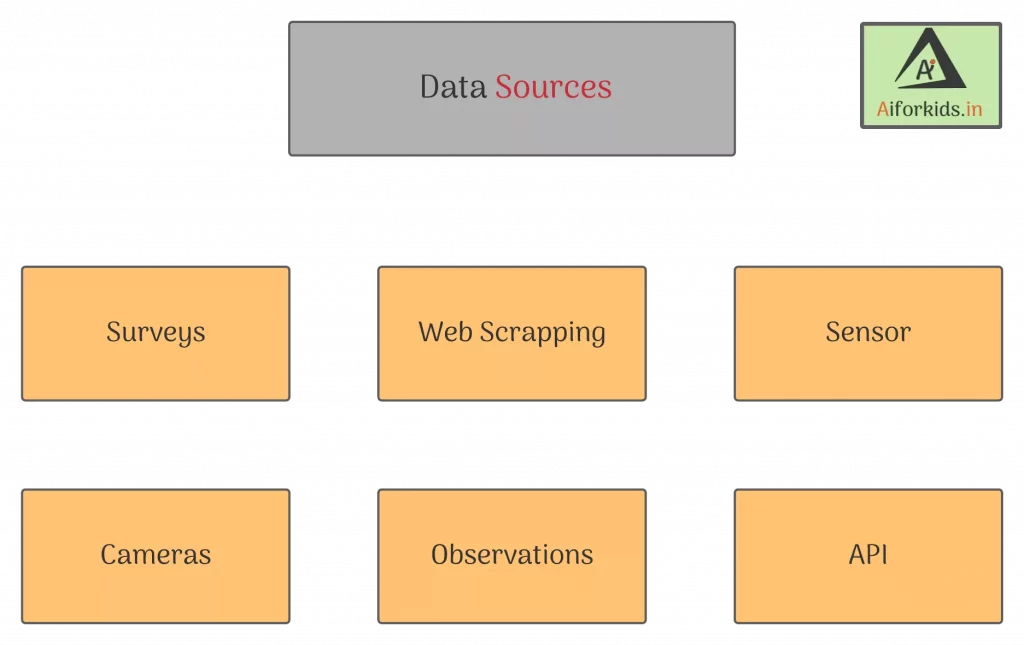
DataSets
DataSet is a collection of different kinds of Data.
For example :
If someone posts something on Facebook he may get Likes, Shares, Dislikes, Comments, etc. All of this is Data, This collection is one Dataset
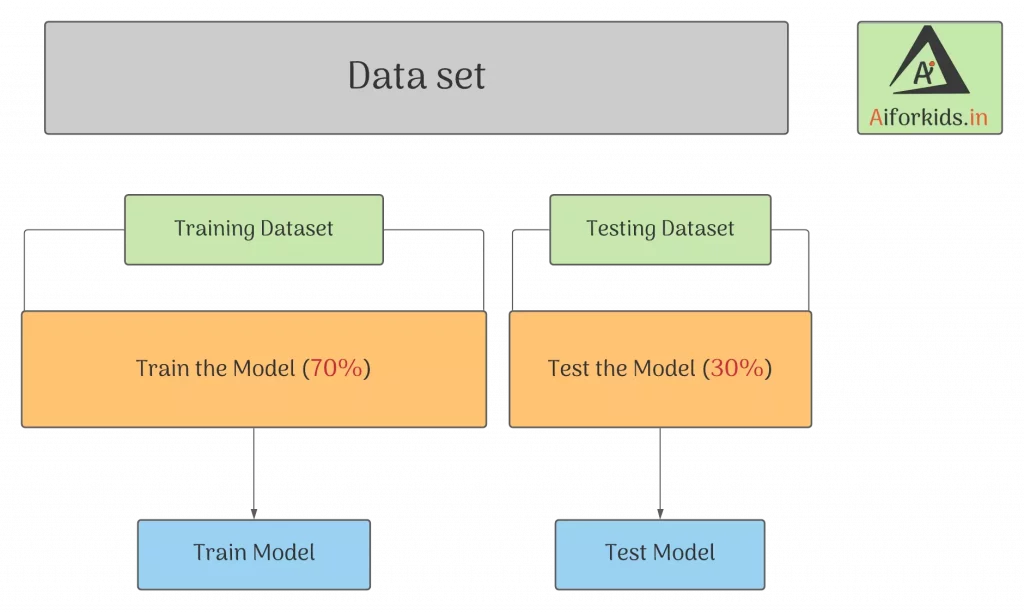
There are two types of data sets :
| Training Dataset | Used for Training the Model ( 70% of the Data ). |
| Testing Dataset | Used for Testing the model ( 30% of the Data ) |
What is Information
Simply Information means more details about Data arranged in some format, Information is the processed, organized, and structured data
Data vs Information
Data
| Data is a collection of Raw facts |
| Data is independent |
| Its measuring unit is: Bits & Bytes |
| Example: test score’s of a student |
Information
| Information is a collection of organized data |
| Information depends on data |
| Its measuring unit is: quantity, time, etc |
| Example: Average score of a class (as drawn from the data) |
Big Data
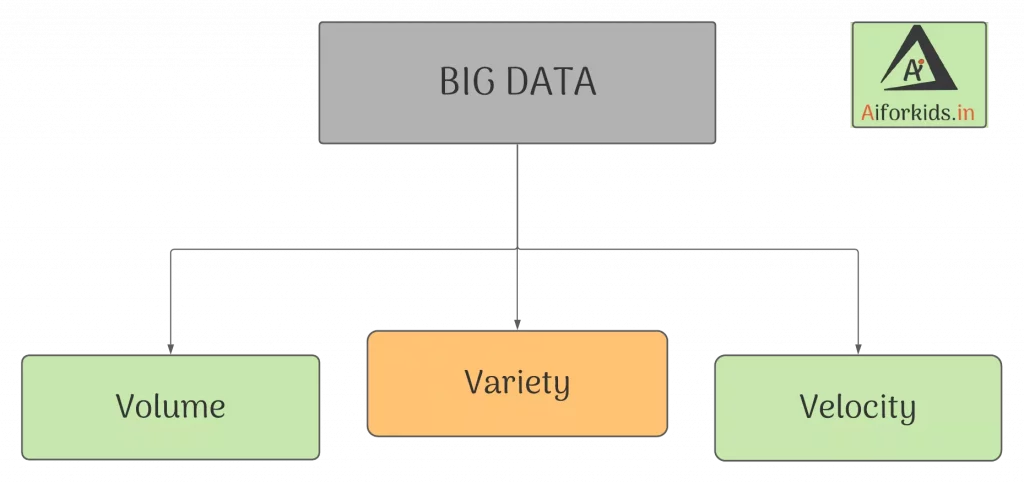
Big Data was originally associated with 3 key Concepts – Volume, Variety, and Velocity
3 Key Concepts in Big Data
| Volume | Amount of Data Produced |
| Variety | Types of Data Produced |
| Velocity | Speed of Data Produced |
Big Data often includes data with sizes that exceed the capacity of traditional software to process within an acceptable time and value.
The term has been used since the 1990s with some giving credit to John Mashey.
Big Data usually includes data sets with sizes beyond the ability of commonly used software tools to Capture, Curate, Manage and process Data within a tolerable elapsed time.
Big Data philosophy and encompasses unstructured, semi-structured, and even structured data. However, the main focus is on unstructured data.
To know more about Data, Visit – Understanding Data
Computer Vision
Computer Vision in simple words is identifying the symbols from the given object (pictures) and learning the pattern and alert or predicting the future object using the camera.
The goal of computer vision is to understand the content of digital images.
Applications of Computer vision
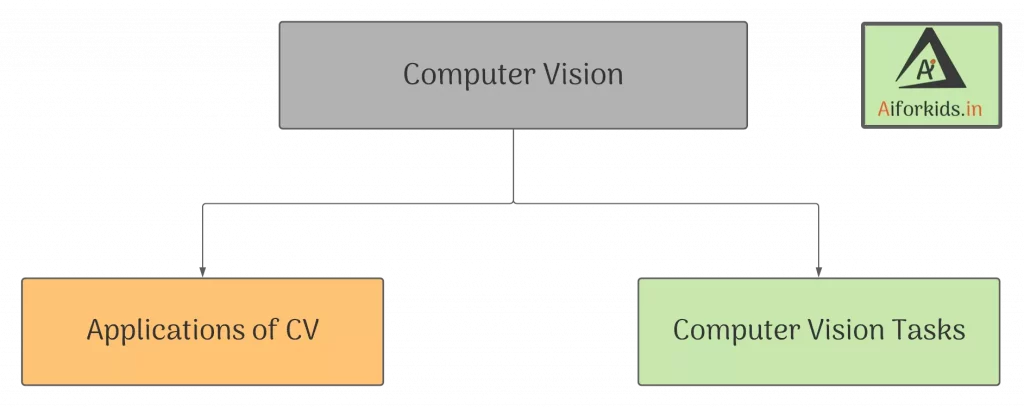
Computer vision was first introduced in the 1970s and now its applications are seen by everyone everywhere
Facial Recognition
A system is a technology that is capable of identifying or verifying a person from a digital image or a video from a video source. For example, it is used by crime investigation agencies
Face filters
By using the applications like Instagram and Snapchat, we can click photographs of various themes, which are based on the usage of Computer vision.
Google lens
To search data, Google uses Computer vision for comparing different features of the input image to the database of images and then gives us the search.
Retail stores
The Newest and most exciting application of Computer vision is the ‘Amazon Go’. it’s an innovative retail store, where there are no cashiers or checkout stations .it is a partially automated store that is created by utilizing computer vision, deep learning.
Source: Amazon
Watch this to learn more about amazon go technology
Automotive
Computer vision is also taking the Automotive industry, Companies like Tesla have developed self-driving cars are which are going to rule the streets in the coming years. Automated cars are equipped with sensors and software which can detect the 360 degrees of movements of pedestrians, cyclists, vehicles, road work.
Healthcare
Technology is helping healthcare professionals accurately classify the conditions and illnesses by reducing and eliminating any inaccurate diagnose and saving patients’ lives.
Google translate App
Google Translate is a free multilingual statistical and neural machine translation service that is provided by Google, to translate text and websites from one language to another language using the device camera.
Computer vision tasks
Applications of computers are based on several tasks that can be performed on the input image so as to perform Analysis or predict the output.
Image classification
Image classification is a task that helps to classify the input image from a set of predefined categories.
Classification + Localization
it is the task which not only identifies the input image but also the location of the image.
Object detection
it is the task to find the instance of an object in an image and hence is known as the process of finding instances of real-world objects.
Instance segmentation
it can be called the next step after the object detection. It is the process of detecting instances of objects.
Computer vision makes automatic checkout possible in modern retail stores as we learn about Retail stores.
Natural Language Processing
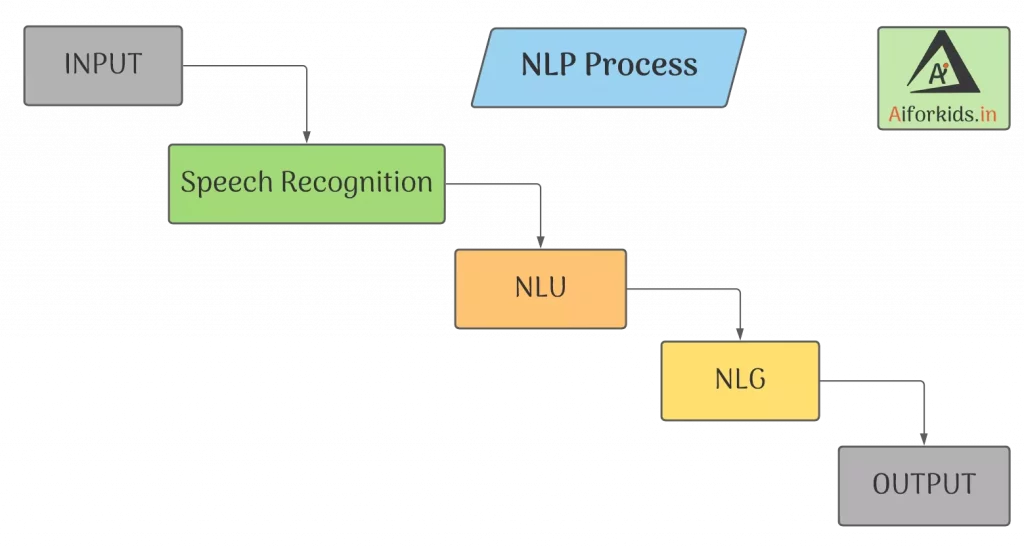
What is NLP ?
The ability of a computer to understand human language (command) as spoken or written and to give an output by processing it, is called Natural Language Processing (NLP). It is a component of Artificial Intelligence.
Let’s understand it in simple words!
Now question yourself why you are able to talk with your friend ?.. Because the words spoken by your friend are taken as input from your ears, your brain processes them and as an output, you respond and the most important thing the language you are using for communication is known to both of you. That’s NLP in simple words!
Process Of NLP
Collecting the information and understanding it, is called Natural Language Understanding (NLU).
Natural Language Understanding (NLU) uses algorithms to convert data spoken or written by the user into a structured data model. It does not require an in-depth understanding of the input but has to deal with a much larger vocabulary.
Two subtopics of NLU:
1. Intent recognition: It is the most important part of NLU because it is the process of identifying the user’s intention in the input and establishing the correct meaning.
2. Entity recognition: It is the process of extracting the most important data in the input such as name, location, places, numbers, date, etc. For example: What happened on 9/11 (date) in the USA (place)
Thinking of appropriate output, to feed the user is called Natural Language Generation (NLG).
Natural Language Generation is a software process of generating natural language output from structured data sets. Its searches for the most relevant output from its network and after arranging it and checking the grammatical mistakes it feeds the best result to the user.
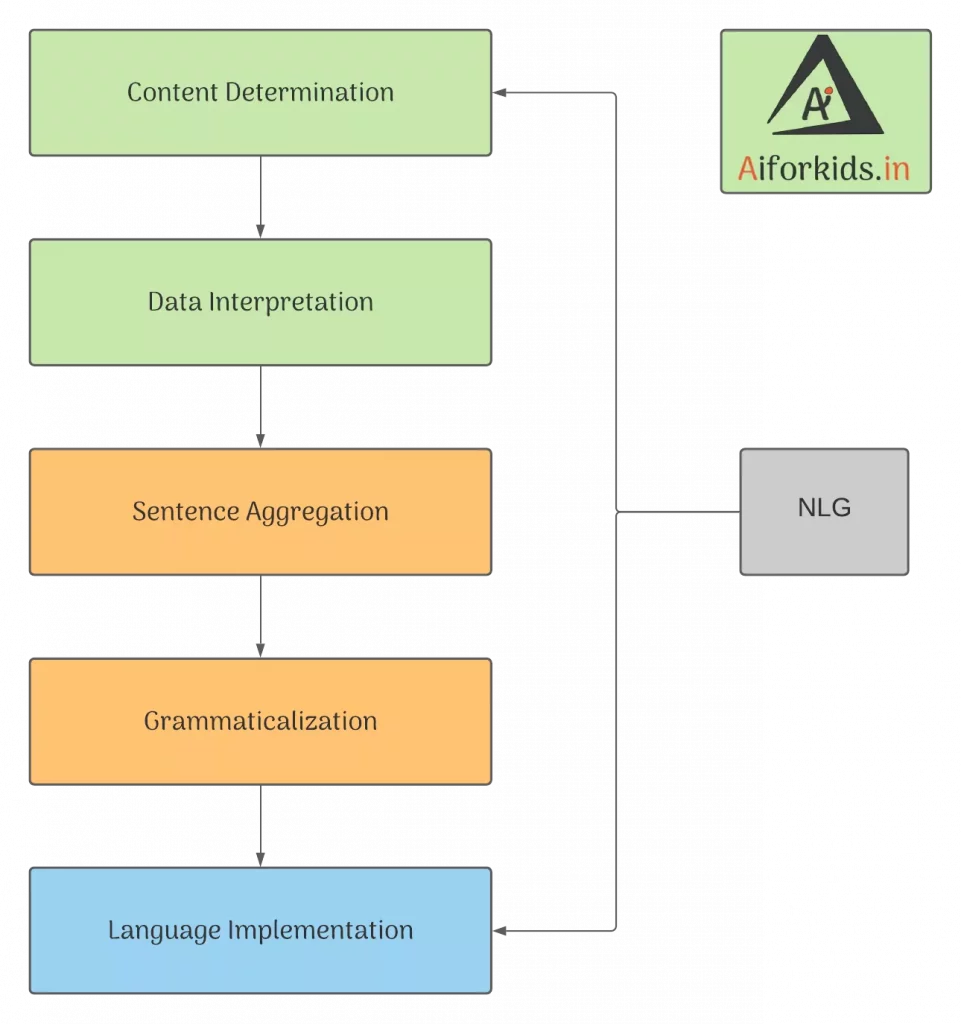
Steps in NLG :-
Content determination: showing only important information or summary for the user’s speech
For example, Google shows only a summary for a Wikipedia search
Data interpretation: Identifying the correct data and showing it to the user with the context of the input.
For Example: In a Cricket match, winners, a man of the match, run rate of the teams.
Sentence Aggregation: The selection of words or expressions in an output sentence. For Example Selection between synonyms such as brilliant or fantastic.
Grammaticalization: As the name suggests, it ensures the output must be according to grammatical patterns and does not have any grammatical mistakes in it. For Example: Using “,” between the text
Language Implementation: Ensuring the output data according to the user’s preferences and putting it into templates.
For Example: When you asked something to Google Assistant, the words or sentences spoken by you is taken as input from your microphone then the Google Assistant recognize your speech and understand it (NLU) then it thinks for an answer (NLG), and after it gives you most relevant ones (output) for your queries!
Applications of NLP
3 Applications of NLP
| Speech Recognition | Speech recognition is when a system is able to give output by understanding or interpreting a user’s speech as an input or a command. Used in: Google Assistant, Apple Siri, Amazon Alexa, etc. |
| Sentimental Analysis | Sentimental Analysis is a process of detecting bad and positive sentiments in a text. Used in: Youtube’s violent or graphic content policies, review of products, identifying spam messages. |
| Machine Translations | Translations of text in a language to another different language by machines. Used in: Google Translate, Youtube cc, Chatbot(s), etc. |
Challenges in NLP
NLP is considered as one of the Hard Problems in AI.
Challenges in NLU
Lexical Ambiguity: Some words have multiple meanings, making it difficult for a machine to understand the correct user’s intent.
For Example, The meaning of Tank could be: Domestic water tank or Army Tank
Syntactic Ambiguity: The structural understanding of the sentence taken by the machine must be valid.
Example: Old man and woman were taken to their home. Here there is old only before men not in women but the sentence means both were old
Semantic Ambiguity: The real meaning of the user’s speech.
Example: The car hits a pole while it was moving. Here moving comes at the end so it is difficult for a machine to understand who was actually hit, car or pole.
Pragmatic Ambiguity: Multiple interpenetrations in user’s speech.
Example: The Police are coming. Here it is not given why the police are coming.
Challenges in NLG
1. It should be Intelligence and Conversational.
2. Deal with structured data
3. Text/Sentence planning
